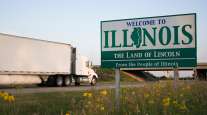I-74 Bridge Replacement Aims to Ease Mobility in Quad Cities Corridor

The Interstate 74 bridge replacement, a tandem project of the Iowa and Illinois departments of transportation, will increase capacity and facilitate mobility on an important corridor that links the two states.
The I-74 bridge, which traverses the Mississippi River, consists of two spans that run from Moline, Ill., to Davenport, Iowa. The two cities help make up the Quad Cities area, the region where eastern Iowa and northwestern Illinois meet.
Danielle Mulholland, I-74 project manager for Iowa DOT, said the goal is to facilitate traffic by widening the bridge from two lanes in each direction to four. The additional lanes will allow “weaving” room to soften the merge onto the bridge and offer additional space for emergency vehicles, according to Mulholland.
“The goal is to improve capacity and mobility for the Quad Cities,” Mulholland said. “That’s the meat of the project. We need more lanes for the anticipated traffic in the years to come.”
Brenda Neville, president of the Iowa Motor Truck Association, said the new bridge will be very positive for the trucking industry because this portion of the state is a busy freight corridor. She said that the new spans will help oversize trucks that struggle on the narrow existing bridge.
Interstates 80 and 280, which form a loop around the Quad Cities, are popular routes and are used to haul commodities such as soybeans, corn, hogs and industrial supplies, according to Neville.
John Deere, the tractor maker, and Alcoa, an aluminum company, have plants in the Quad Cities that account for many of the industrial hauls in the area. Illinois DOT representative Kelsea Gurski said that cereal grains, gravel, chemical products and coal also move through the area.
“It’s a very important project for trucking. It’s an important bridge; it’s an important corridor,” Neville said. “Making improvements on that bridge will be really critical. That’s just a big trucking area.”
The bridge also will have a path for pedestrians and bicycles. The bridge is scheduled to open in November 2020, and the old bridge is scheduled for demolition the following year.

Rendering of the new I-74 bridge.
The I-74 bridge handles about 74,000 vehicles a day. Mulholland said 45% of the trips that move through the Quad Cities area and over the Mississippi River use that bridge. She reported that 4% to 5% of the traffic that crosses the bridge consists of trucks. Truck drivers frequently use I-80 and I-280 when navigating the area in order to avoid congestion on the bridge, Mulholland said.
“I think it’s going be much more accessible. Right now, if somebody gets a flat tire on the bridge, it shuts down,” Mulholland said. “When we expand the lane width availability, that’s really going to help out for getting across the river more efficiently.”
The westbound span of the I-74 bridge, which carries traffic moving from Illinois to Iowa, is 83 years old, while the eastbound span, from Iowa to Illinois, is 59 years old. The bridge’s age necessitates periodic rehabilitation projects. Iowa DOT Aesthetic Bridge Specialist Kimball Olson said it is not uncommon for at least one lane on the two-lane spans to be closed for repairs.
The most recent round of maintenance happened last fall, Mulholland said.
“Sixty- and 80-year-old bridges need a lot of attention. These two have both had numerous rehabilitation projects throughout their lifetimes,” Olson said. “As bridges age, they need more attention, and they have to be shut down to get that attention.”
Iowa DOT is teaching people about the project partly through a virtual reality display, which the agency showcased at the Transportation Research Board annual meeting in early January. Through a virtual reality headset, a viewer can stand on a rendering of the new bridge’s pedestrian path, hover over the bridge to get a bird’s eye view and study the old bridge as it compares to its replacement.
“Part of mitigation is to include a local understanding of [the] issues. You might show somebody a map of the river with the new bridge on it, but they can’t really tell where it is relative to the old bridges, even if you have a map with the old bridges,” Olson said. “Putting it into that three dimensional environment makes it potentially more clear to them the relationship of the old to the new and how things will be organized after the rebuild.”




